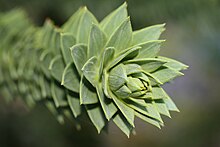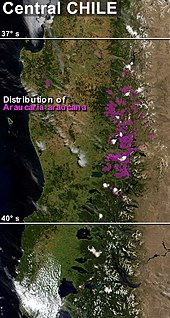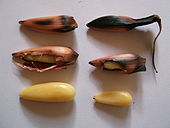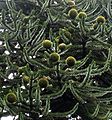Araucaria araucana
| Araucaria araucana | |
|---|---|

| |
| Scientific classification | |
| Kingdom: | Plantae |
| Clade: | Tracheophytes |
| Clade: | Gymnospermae |
| Division: | Pinophyta |
| Class: | Pinopsida |
| Order: | Araucariales |
| Family: | Araucariaceae |
| Genus: | Araucaria |
| Section: | A. sect. Araucaria |
| Species: | A. araucana
|
| Binomial name | |
| Araucaria araucana (Molina) K. Koch
| |
Araucaria araucana, commonly called the monkey puzzle tree, monkey tail tree, piñonero, pewen or Chilean pine, is an evergreen tree growing to a trunk diameter of 1–1.5 m (3.3–4.9 ft) and a height of 30–40 m (98–131 ft). It is native to central and southern Chile and western Argentina.[3] It is the hardiest species in the conifer genus Araucaria. Because of the prevalence of similar species in ancient prehistory, it is sometimes called a living fossil. It is also the national tree of Chile. Its conservation status was changed to Endangered by the IUCN in 2013 due to the dwindling population caused by logging, forest fires, and grazing.[1]
Description


The leaves are thick, tough, and scale-like, triangular, 3–4 cm (1+1⁄4–1+1⁄2 in) long, 1–3 cm (1⁄2–1+1⁄4 in) broad at the base, and with sharp edges and tips. According to Lusk, the leaves have an average lifespan of 24 years[4] and so cover most of the tree except for the older branches.
It is usually dioecious, with the male and female cones on separate trees, though occasional individuals bear cones of both sexes. The male (pollen) cones are oblong and cucumber-shaped, 4 cm (1+1⁄2 in) long at first, expanding to 8–12 cm (3–4+1⁄2 in) long by 5–6 cm (2–2+1⁄2 in) broad at pollen release. It is wind pollinated. The female (seed) cones, which mature in autumn about 18 months after pollination, are globose, large, 12–20 cm (4+1⁄2–8 in) in diameter, and hold about 200 seeds. The cones disintegrate at maturity to release the 3–4 cm (1+1⁄4–1+1⁄2 in) long nut-like seeds.
The thick bark of Araucaria araucana may be an adaptation to wildfire.[5]
Habitat

The tree’s native habitat is the lower slopes of the Chilean and Argentine south-central Andes, typically above 1,000 m (3,300 ft). Juvenile trees exhibit a broadly pyramidal or conical habit which naturally develops into the distinctive umbrella form of mature specimens as the tree ages.[6] It prefers well-drained, slightly acidic, volcanic soil, but will tolerate almost any soil type provided it drains well. Seedlings are often not competitive enough to survive unless grown in a canopy gap or exposed isolated area.[7] The species is hardly ever found in the same communities as Husquea culeou, Nothofagus dombeyi and Nothofagus pumilio, this is due to these species out competing the A. araucana individuals[7]
Seed dispersal
Araucaria araucana is a masting species, and rodents are important consumers and dispersers of its seeds. The long-haired grass mouse, Abrothrix longipilis, is the most important animal responsible for dispersing the seeds of A. araucana. This rodent buries seeds whole in locations favorable for seed germination, unlike other animals.[8]
Another important seed dispersal agent is members of the parakeet species Enicognathus ferrugineu[7]s. Adult trees are highly resistant to large ecological disturbances caused by volcanic activity, after events like these the parakeets play their role by dispersing the seeds far from effected territory.[7]
Threats
Logging, long a major threat, was finally banned in 1990.[9] Large fires burned thousands of acres of Araucaria forest in 2001–2002,[9] and areas of national parks have also burned, destroying trees over 1300 years old.[1] Overgrazing and invasive trees are also threats.[1][9] Extensive human harvesting of piñones (Araucaria seeds) can prevent new trees from growing.[1] A Global Trees Campaign project that planted 2000 trees found a 90 percent 10-year survival rate.[9]
Cultivation and uses
Araucaria araucana is a popular garden tree, planted for the unusual effect of its thick, "reptilian" branches with very symmetrical appearance. It prefers temperate climates with abundant rainfall, tolerating temperatures down to about −20 °C (−4 °F). It is far and away the hardiest member of its genus, and can grow well in western and central Europe (north to the Faroe Islands and Smøla[10] in western Norway), the west coast of North America (north to Baranof Island in Alaska), and locally on the east coast, as far north as Long Island, and in New Zealand, southeastern Australia and south east Ireland. It is tolerant of coastal salt spray, but does not tolerate exposure to pollution.[citation needed]

Its piñones, or seeds,[9] are edible, similar to large pine nuts, and are harvested by indigenous peoples in Argentina and Chile.[11] The tree has some potential to be a food crop in other areas in the future, thriving in climates with cool oceanic summers, e.g., western Scotland, where other nut crops do not grow well.[12] A group of six female trees with one male for pollination could yield several thousand seeds per year. Since the cones drop, harvesting is easy. The tree, however, does not yield seeds until it is around 30 to 40 years old, which discourages investment in planting orchards (although yields at maturity can be immense); once established, individuals can achieve ages beyond 1,000 years.[13][14] Pest losses to rodents and feral Sus scrofa limits the yields for human consumption and forage fattening of livestock by A. araucana mast.[15] A. araucana has a high degree of inter-year variability in mast volume, and this variation is synchronous within a given area.[16] This evolved to take advantage of predator satiety.[16]
Once valued because of its long, straight trunk, its current rarity and vulnerable status mean its wood is now rarely used; it is also sacred to some members of the Mapuche Native American tribe.[17] Before the tree became protected by law in 1971, lumber mills in Araucanía Region specialized in Chilean pine.
The species is protected under Appendix I of the Convention on International Trade in Endangered Species (CITES) meaning international trade (including in parts and derivatives) is regulated by the CITES permitting system and commercial trade in wild sourced specimens is prohibited.[2]
Naming


First identified by Europeans in Chile in the 1780s,[18][19] it was named Pinus araucana by Molina in 1782.[20] In 1789, de Jussieu erected a new genus called Araucaria based on the species,[21] and in 1797, Pavón published a new description of the species which he called Araucaria imbricata (an illegitimate name, as it did not use Molina's older species epithet).[22] Finally, in 1873, after several further redescriptions, Koch published the combination Araucaria araucana,[23] validating Molina's species name. The name araucana is derived from the native Araucanians who used the nuts (seeds) of the tree in Chile. A group of Araucanians living in the Andes, the Pehuenches, owe their name to their diet based on the harvesting of the A. araucaria seeds. Pehuen means Araucaria and che means people in Mapudungun.
The origin of the popular English language name "monkey puzzle" derives from its early cultivation in Britain in about 1850, when the species was still very rare in gardens and not widely known. Sir William Molesworth, the owner of a young specimen at Pencarrow garden near Bodmin in Cornwall, was showing it to a group of friends, when one of them – the noted barrister and Benthamist Charles Austin – remarked, "It would puzzle a monkey to climb that".[24] As the species had no existing popular name, first "monkey puzzler", then "monkey puzzle" stuck.[25]
Relatives
The nearest extant relative is Araucaria angustifolia, a South American Araucaria from Brazil which differs in the width of the leaves. Members of other sections of the genus Araucaria occur in Pacific Islands and in Australia, and include Araucaria cunninghamii, hoop pine, Araucaria heterophylla, the Norfolk Island pine and Araucaria bidwillii, bunya pine.
The recently found 'Wollemi pine', Wollemia, discovered in southeast Australia, is classed in the plant family Araucariaceae. Their common ancestry dates to a time when Australia, Antarctica, and South America were linked by land – all three continents were once part of the supercontinent known as Gondwana.
Gallery
-
Araucaria araucana in the Argentine Andes
-
Bark of a tree in Conguillío National Park, Chile
-
Female cones
-
Male cones
-
Part of a branch of a cultivated tree
-
A. araucana, Botanical Garden, Wrocław, Poland
-
A. araucana branch
-
Monkey puzzle trees are popularly grown as ornamental trees.
-
Juvenile tree in winter
-
Mixed forest of Araucaria and coigüe in Nahuelbuta National Park, Chile
-
Araucaria araucana in Botanical Garden Jevremovac (Belgrade)
References
- ^ a b c d e Premoli, A.; Quiroga, P.; Gardner, M. (2013). "Araucaria araucana". IUCN Red List of Threatened Species. 2013: e.T31355A2805113. doi:10.2305/IUCN.UK.2013-1.RLTS.T31355A2805113.en. Retrieved 12 November 2021.
- ^ a b "Appendices | CITES". cites.org. Retrieved 14 January 2022.
- ^ Native areas Archived 16 May 2012 at the Wayback Machine, Kew Royal Botanic Gardens. Retrieved: 2012-09-20.
- ^ Lusk, Christopher H. (2001). "Leaf life spans of some conifers of the temperate forests of South America" (PDF). Revista Chilena de Historia Natural. 74 (3): 711–718. doi:10.4067/S0716-078X2001000300017. Retrieved 6 November 2017.
- ^ Veblen, Thomas T.; Kitzberger, Thomas; Burns, Bruce R.; Rebertus, Alan J. (1995). "Perturbaciones y dinámica de regeneración en bosques andinos del sur de Chile y Argentina" [Natural disturbance and regeneration dynamics in Andean forests of southern Chile and Argentina]. In Armesto, Juan J.; Villagrán, Carolina; Arroyo, Mary Kalin (eds.). Ecología de los bosques nativos de Chile (in Spanish). Santiago de Chile: Editorial Universitaria. pp. 169–198. ISBN 978-9561112841.
- ^ Michael A. Arnold (2004). "Araucaria Araucana" (PDF). Landscape Plants For Texas And Environs 3rd. Aggie Horticulture. ISBN 978-1588747464.
- ^ a b c d Finckh, Manfred; Paulsch, Axel (November 1995). "Araucaria araucana — Die ökologische Strategie einer Reliktkonifere". Flora. 190 (4): 365–382. doi:10.1016/s0367-2530(17)30679-5. ISSN 0367-2530.
- ^ Shepherd, J.D. & R.S. Ditgen, 2013. Rodent handling of Araucaria araucana seeds. Austral Ecology, 38: 23–32.
- ^ a b c d e "Monkey Puzzle". Global Trees.
- ^ Gallo, L., F. Izquierdo, L.J. Sanguinetti, A. Pinna, G. Siffredi, J. Ayesa, C. Lopez, A. Pelliza, N. Strizler, M. Gonzales Peñalba, L. Maresca and L. Chauchard. 2004. Araucaria araucana forest genetic resources in Argentina. Pages 105-132 in Barbara Vinceti, Weber Amaral and Brien Meilleur (eds). Challenges in managing forest genetic resources for livelihoods: examples from Argentina and Brazil. International Plant Genetic Resources Institute. 271 pp.
- ^ "It's hard to be leaf but Scotland can save the monkey puzzle tree from extinction".
- ^ Lüning, Sebastian; Gałka, Mariusz; Bamonte, Florencia Paula; Rodríguez, Felipe García; Vahrenholt, Fritz (2019). "The Medieval Climate Anomaly in South America". Quaternary International. 508. International Union for Quaternary Research (Elsevier): 70–87. Bibcode:2019QuInt.508...70L. doi:10.1016/j.quaint.2018.10.041. ISSN 1040-6182. S2CID 133405753.
- ^ Aguilera-Betti, Isabella; Muñoz, Ariel A.; Stahle, Daniel; Figueroa, Gino; Duarte, Fernando; González-Reyes, Álvaro; Christie, Duncan; Lara, Antonio; González, Mauro E.; Sheppard, Paul R.; Sauchyn, David; Moreira-Muñoz, Andrés; Toledo-Guerrero, Isadora; Olea, Matías; Apaz, Pablo; Fernandez, Alfonso (2017). "The First Millennium-Age Araucaria Araucana in Patagonia". Tree-Ring Research. 73 (1). Tree-Ring Society: 53–56. doi:10.3959/1536-1098-73.1.53. ISSN 1536-1098. S2CID 133405753.
- ^ Sanguinetti, Javier; Kitzberger, Thomas (10 May 2009). "Factors controlling seed predation by rodents and non-native Sus scrofa in Araucaria araucana forests: potential effects on seedling establishment". Biological Invasions. 12 (3). Springer Science and Business Media LLC: 689–706. doi:10.1007/s10530-009-9474-8. ISSN 1387-3547. S2CID 21054740.
- ^ a b Sanguinetti, Javier; Kitzberger, Thomas (6 January 2008). "Patterns and mechanisms of masting in the large-seeded southern hemisphere conifer Araucaria araucana". Austral Ecology. 33 (1). Wiley Publishing: 78–87. doi:10.1111/j.1442-9993.2007.01792.x. ISSN 1442-9985.
- ^ Anna Lewington & Edward Parker (1999). Ancient Trees. Collins & Brown. ISBN 978-1-85585-974-6.
- ^ The tree was first mentioned in 1780 by the Spaniard Francisco Dendariarena. See:
- Elwes, Henry John; Henry, Augustine (1906). The Trees of Great Britain & Ireland. Vol. 1. Edinburgh, Scotland: (Privately printed). pp. 45–46.
- Hansen, Carl (1892). "Pinetum danicum". Journal of the Royal Horticultural Society. 14: 257–480., see p. 341.
- Lambert, Aylmer Bourke (1832). A Description of the Genus Pinus …. Vol. 2. London, England: Weddell. pp. 106–108.
- ^ However, there are claims that the monkey puzzle tree was introduced to Europe after an expedition by the Dutch in 1642 from Brazil to Valdivia, Chile. See:
- Devon Gardens Trust
- Diedenhofen, Wilhelm (1990). ""Belvedere," or the principle of seeing and looking in the gardens of Johan Maurits van Nassau-Siegen at Cleves". In Hunt, John Dixon (ed.). The Dutch Garden in the Seventeenth Century. Washington, D.C.: Dumbarton Oaks. pp. 49–80. ISBN 9780884021872., see p. 69.
- ^ Molina, Giovanni Ignazio (1782). Saggio sulla storia naturale del Chili [Essay on the natural history of Chile] (in Italian and Latin). Bologna, (Italy): S. Tomasso d'Aquino. p. 355. Available at: Real Jardín Botánico (Royal Botanical Garden), CSIC, Madrid, Spain. Archived 8 November 2016 at the Wayback Machine
- ^ Jussieu, Antoine Laurent de (1789). Genera plantarum: secundum ordines naturales disposita, … [The genera of plants: arranged according to the natural orders, …] (in Latin). Paris, France: Herissant. pp. 413–414.
- ^ Pavón, Joseph (1797). "Disertacion botanica sobre los generos Tovaria, Actinophyllum, Araucaria y Salmia, con la reunion de algunos que Linneo publicó como distintos" [Botanical dissertation on the genera Tovaria, Actinophyllum, Araucaria and Salmia, with the recombining of some [genera] that Linnaeus had published as [being] distinct]. Memorias de la Real Academia Médica de Madrid (Memoirs of the Royal Medical Academy of Madrid) (in Spanish). 1: 191–204. ; see p. 199.
- ^ Koch, Karl (1873). Dendrologie. Bäume, Sträucher und Halbsträucher, welche in Mittel- und Nord-Europa im Freien kultivirt werden [Dendrology. Trees, shrubs, and subshrubs which are cultivated outdoors in Middle and Northern Europe.] (in German). Vol. 2, part 2. Erlangen, Germany: Ferdinand Enke. p. 206.
- ^ Wilson, Matthew (5 July 2013). "Riddle of how the monkey puzzle tree came to be a UK favourite". Financial Times. Archived from the original on 10 December 2022. Retrieved 14 May 2016.
- ^ Alan Mitchell (1996). Alan Mitchell's Trees of Britain. Collins. ISBN 978-0-00-219972-8.
External links
- Premoli, A.; Quiroga, P.; Gardner, M. (2013). "Araucaria araucana". IUCN Red List of Threatened Species. 2013: e.T31355A2805113. doi:10.2305/IUCN.UK.2013-1.RLTS.T31355A2805113.en. Retrieved 12 November 2021. Listed as Vulnerable (VU B1+2c v2.3)
- "Gymnosperm Database: Araucaria araucana". Conifers.org.
- "Araucaria araucana". Encyclopedia of the Chilean Flora.
- "Araucaria araucana". Chilebosque.
- "Threatened Trees: Monkey Puzzle". Global trees campaign.
- "The growth stages". Araucaria araucana.
- "Araucaria araucana – Monkey Puzzle Tree". Conifers Around the World. Archived from the original on 6 September 2013. Retrieved 26 March 2013.












